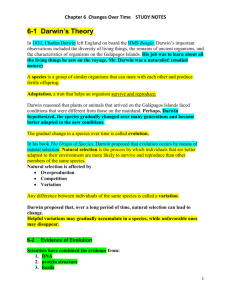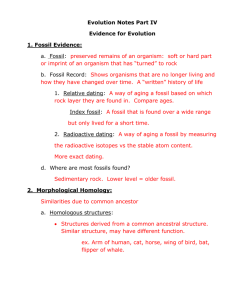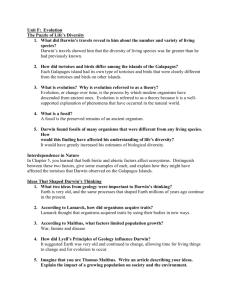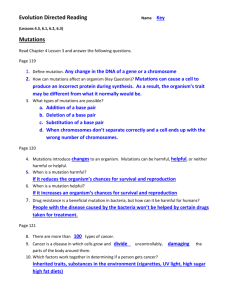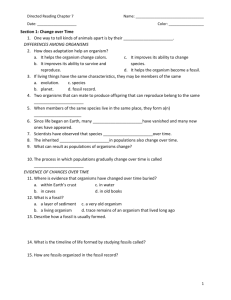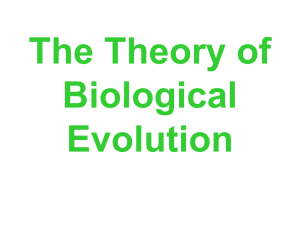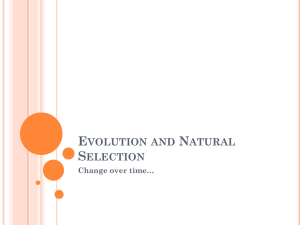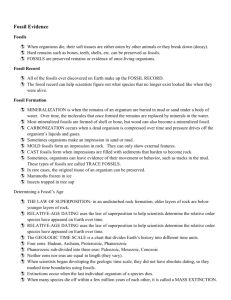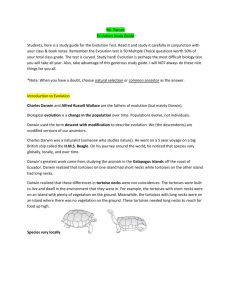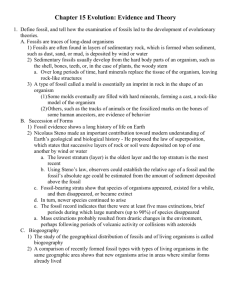Evolutionary theory outline
advertisement
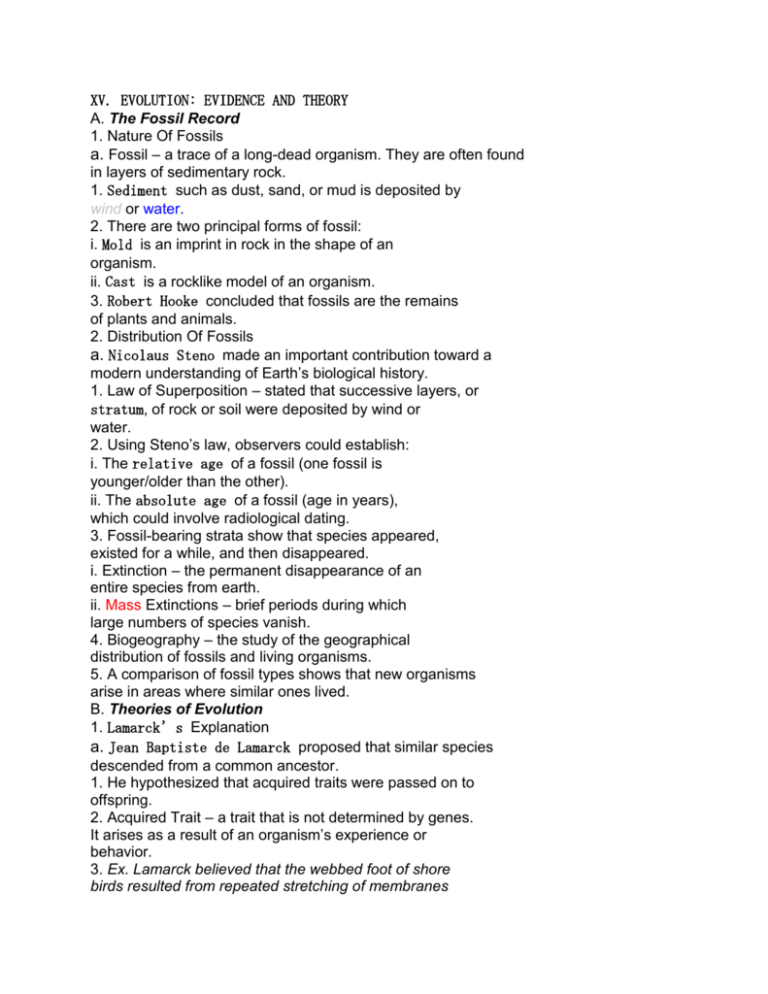
XV. EVOLUTION: EVIDENCE AND THEORY A. The Fossil Record 1. Nature Of Fossils a. Fossil – a trace of a long-dead organism. They are often found in layers of sedimentary rock. 1. Sediment such as dust, sand, or mud is deposited by wind or water. 2. There are two principal forms of fossil: i. Mold is an imprint in rock in the shape of an organism. ii. Cast is a rocklike model of an organism. 3. Robert Hooke concluded that fossils are the remains of plants and animals. 2. Distribution Of Fossils a. Nicolaus Steno made an important contribution toward a modern understanding of Earth’s biological history. 1. Law of Superposition – stated that successive layers, or stratum, of rock or soil were deposited by wind or water. 2. Using Steno’s law, observers could establish: i. The relative age of a fossil (one fossil is younger/older than the other). ii. The absolute age of a fossil (age in years), which could involve radiological dating. 3. Fossil-bearing strata show that species appeared, existed for a while, and then disappeared. i. Extinction – the permanent disappearance of an entire species from earth. ii. Mass Extinctions – brief periods during which large numbers of species vanish. 4. Biogeography – the study of the geographical distribution of fossils and living organisms. 5. A comparison of fossil types shows that new organisms arise in areas where similar ones lived. B. Theories of Evolution 1. Lamarck’s Explanation a. Jean Baptiste de Lamarck proposed that similar species descended from a common ancestor. 1. He hypothesized that acquired traits were passed on to offspring. 2. Acquired Trait – a trait that is not determined by genes. It arises as a result of an organism’s experience or behavior. 3. Ex. Lamarck believed that the webbed foot of shore birds resulted from repeated stretching of membranes between toes. 52 i. Offspring of birds with webbed feet would acquire that trait from their parents. ii. If an organism did not use a certain part of its body, a smaller version of that part would be passed on. 4. His hypothesis was easily disproved, but laid out the foundations for the eventual work of Charles Darwin. 2. The Beginning Of Evolutionary Thought a. Natural Selection – organisms best suited for their environment reproduce more successfully. 1. Population – a group of organisms of the same species. 2. Over time, the proportion of organisms with more favorable traits increases. b. Charles Darwin was born in 1809 to a wealthy British physician. 1. In 1831, Darwin sailed aboard the H.M.S. Beagle as the ship’s naturalist for five years. i. Uniformitarianism – the geological structure of Earth results from cycles. Detailed in Principles of Geology by Charles Lyell. ii. In Chile, Darwin observed fossil shells in rock beds more than 4 km above ground. He reasoned that the formation of mountains slowly changed habitats. c. Alfred Wallace approached Darwin with his own paper on natural selection, prompting Darwin to publish his own work. 1. Both their hypotheses were presented to the Linnean Society of London in 1858. 2. A year later, Darwin published On the Origin of Species. 3. Darwin’s Theories a. Darwin’s ideas about evolution and natural selection are summed up in two theories: 1. Descent with modification – newer forms appearing in fossil records are actually the modified descendants of older species. 2. Modification by natural selection – states how evolution occurs. Darwin was influenced by Thomas Malthus. b. Adapt – an organism becomes better suited to its habitat. c. Fitness – a single organism’s genetic contribution. C. Evolution in Process 1. Evidence Of Evolution a. Homologous Features – similar features that originated in a shared ancestor. 53 1. Ex. beaks of birds, similar forelimbs of penguins, alligators, bats, and humans. b. Analogous Features – serve identical functions and look somewhat alike. 1. They have very different embryological development and may differ in anatomy. 2. Ex. A hummingbird and a humming moth both hover to feed off of flower nectar, but do not share anatomy or embryological structure. c. Vestigial Features – features that seem to serve no useful function in an organism. 1. A vestigial feature in a modern organism is evidence that the structure was used in some ancestor. 2. Ex. humans tailbones, appendix, whale pelvis. d. The early stages of different vertebrate embryos are strikingly similar to each other. e. Ernst Haeckel stated that embryological development repeats evolutionary history. 1. His statement was over exaggerated; as during no stage of development does a fish resemble a gorilla. 2. All vertebrate embryos are similar, but those similarities fade as development continues. f. Darwin hypothesized that more similar forms of organisms have a more recent common ancestor than less-similar forms. 2. Patterns Of Evolution a. Coevolution – the change of two or more species in close association with each other. Ex. plants and pollinators. b. Convergent Evolution – organisms that appear to be similar are not related at all. Ex. sharks and dolphins. c. Divergent Evolution – two or more related populations or species become increasingly dissimilar. 1. Adaptive Radiation – many related species evolve from a single ancestral species. Ex. Galápagos finches, which diverged in response to food availability. 2. Artificial Selection – selection for reproductive success in plants and animals that is directed by humans. Ex. domestic dogs are all members of the same species but come in multiple “breeds”.
